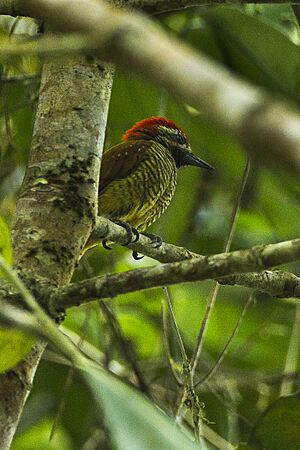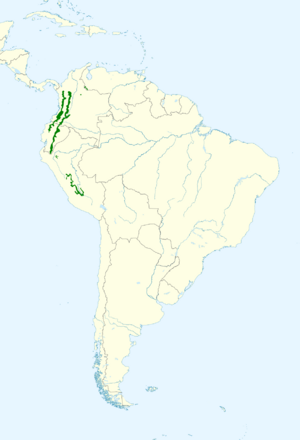Yellow-vented woodpecker facts for kids
Quick facts for kids Yellow-vented woodpecker |
|
|---|---|
 |
|
| Conservation status | |
| Scientific classification | |
| Genus: |
Veniliornis
|
| Species: |
dignus
|
 |
|
| Synonyms | |
|
|
The yellow-vented woodpecker (Veniliornis dignus) is a type of bird that belongs to the woodpecker family. You can find this colorful bird in countries like Colombia, Ecuador, Peru, and Venezuela. It's known for its unique look and how it lives in the forests.
Contents
How Scientists Classify This Bird
Scientists group animals to understand them better. The yellow-vented woodpecker is usually placed in a group (genus) called Veniliornis. However, some scientists, like those from the American Ornithological Society, decided to move all birds from Veniliornis into another group called Dryobates. It's like how different libraries might organize books in slightly different ways!
This woodpecker also has three main types, called subspecies. They are:
- dignus (the main type)
- baezae
- valdizani
What Does It Look Like?
The yellow-vented woodpecker is about 16 to 17 centimeters (6 to 7 inches) long. It weighs between 35 and 46 grams (1.2 to 1.6 ounces). That's about the weight of a small candy bar!
Males and females look very similar, except for their heads.
- Both have a dark, olive-black face with white stripes. These stripes are found behind and below their eyes.
- Males have a red cap from their forehead to the back of their neck.
- Females have a completely blackish cap in the same area.
The rest of their body is also interesting:
- Their back is yellow-green with a shiny bronze color.
- Their lower back and tail feathers have light and dark olive stripes.
- Their wings are brownish-olive.
- Their tail is dark with a yellow tint, and the outer feathers have pale stripes.
- Their belly is greenish-white, turning yellow near their sides. They have dark olive-black stripes from their throat down to their sides.
Their eyes are brown to reddish-brown. Their beak is medium-long and dark, with a lighter base. Their legs are dark olive-gray. Young woodpeckers look a bit duller than adults. They also have greener upper parts and some red tips on their head feathers.
The different subspecies have small differences too. For example, baezae has a shorter beak. valdizani has a longer beak and less clear stripes on its lower back.
Where Does It Live?
The yellow-vented woodpecker lives in different parts of South America.
- The dignus subspecies lives in southwestern Venezuela and down through the Andes mountains in Colombia and northern Ecuador.
- The baezae subspecies lives on the eastern side of the Andes in Ecuador.
- The valdizani subspecies lives on the eastern side of the Andes in Peru.
This bird loves to live in humid montane forests, especially cloudforests. These are forests high up in the mountains where clouds often cover the trees. It usually stays in old, untouched forests. You'll mostly find it at elevations between 1,200 and 2,700 meters (about 3,900 to 8,900 feet). Sometimes, in Peru, it can be found as low as 700 meters (about 2,300 feet).
How It Behaves
Staying Put
The yellow-vented woodpecker does not migrate. It stays in the same area all year round.
What's for Dinner?
This woodpecker looks for food from the middle parts of the forest all the way up to the treetops. It usually hunts alone or in pairs. Sometimes, it joins groups of different bird species looking for food together. It often spends a long time in one spot. It will hammer on a tree trunk or branch to find food. We don't know exactly what it eats, but it's likely insects found under the bark.
Reproduction and Life Cycle
Scientists believe the yellow-vented woodpecker's breeding season is between March and August. However, not much else is known about how these birds raise their young. More research is needed to understand their family life!
What Does It Sound Like?
The yellow-vented woodpecker is not a very noisy bird. When it does make a sound, it's described as a fast, rattling "krrrrrrrrrrrrrrr."
Its Status in the Wild
The IUCN (International Union for Conservation of Nature) has looked at the yellow-vented woodpecker. They have decided it is a species of "Least Concern." This means it is not currently in danger of disappearing. It lives across a large area. Even though we don't know its exact population size, scientists believe it is stable. No immediate threats have been found. It is considered rare in Peru and not very common in other places. It might be widespread but lives in very small numbers in each area.


